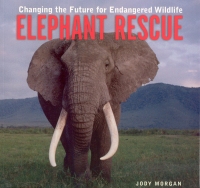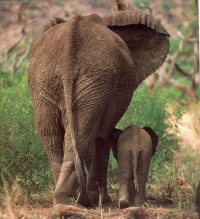| ________________
CM . . .
. Volume XI Number 11 . . . .February 4, 2005
excerpt: Years ago, hunters paid tens of thousands of dollars for the chance to shoot and kill a bull elephant in South Africa's Timbavati Private Nature Reserve. Today, they pay the same amount to shoot and tranquilize the animal with a dart. The elephant suffers no harm, researchers can fit the elephant with a radio collar and money is brought in for conservation. Iain Douglas-Hamilton came up with the idea of 'green hunting' as an alternative to lethal sport- hunting. It's a win-win situation, as he explains. "For those who find an elephant too intelligent to shoot for sport, here you can have a sporting hunt without an ethical downside, while helping conserve the species." What do most of us know about elephants? They're the world's largest land mammal, they've resided on Earth for millions of years, and we've heard they "never forget." We may know they're endangered: as the human population explodes, the available habitat for such enormous animals is rapidly "imploding." We may not be aware of the severity of modern threats to elephant survival or what is being done to mitigate them, and that's the focus of this book, part of the "Firefly Animal Rescue" series. The author takes these commonly known elephant facts and uses them to detail first the ways in which this animal's characteristics make it vulnerable in today's world and then to show some of the conservation measures that are being implemented to reverse the negative trends. You'll learn about tusks, for example, and then discover how the ivory trade has resulted in a serious depletion of the largest elephants, those needed to keep the gene pool strong. Those older elephants are also the herd leaders whose exceptional memory is relied on by the rest "to find traditional sources of food and water, raise calves and defend themselves." Amazingly, it was only in 1990 that a worldwide ban on ivory trading was put in place, and it is by no means secure. Poaching continues despite efforts to enforce the laws in many African and Asian countries.
Two pages of "Fast Facts" give the reader an overview of this animal's unique features. Another two pages offer sources of additional information, mainly in the form of conservation organizations and websites. With its up-to-date data complemented by color photographs, this book will go a long way to educating young readers, as well as adults, about the fate of one of the world's most intelligent and fascinating creatures. Highly Recommended. A freelance writer and former teacher-librarian, Gillian Richardson lives in BC.
To comment
on this title or this review, send mail to cm@umanitoba.ca.
Copyright © the Manitoba Library Association. Reproduction for personal
use is permitted only if this copyright notice is maintained. Any
other reproduction is prohibited without permission.
NEXT REVIEW |
TABLE OF CONTENTS FOR THIS ISSUE
- February 4, 2005.
AUTHORS |
TITLES |
MEDIA REVIEWS |
PROFILES |
BACK ISSUES |
SEARCH |
CMARCHIVE |
HOME |

 Green hunting is one imaginative attempt to solve the problem of educating the public about the
threats to elephants. The book profiles five researchers who have dedicated years of study to
helping save the remaining elephant populations. As the data bank of knowledge increases from
their efforts, projects such as the South African Peace Parks, where traditional elephant migration
routes are being restored across political borders, and the Elephant Listening Project, in which the
study of the animals' communication is helping to determine their habitat needs. The book
examines the controversial question of the zoo as an alternative lifestyle for elephants and
describes an elephant orphanage in Kenya whose objective is to reintroduce the animals to the
wild. One scientist warns that "ours may be the generation that decides [the elephants'] fate."
Green hunting is one imaginative attempt to solve the problem of educating the public about the
threats to elephants. The book profiles five researchers who have dedicated years of study to
helping save the remaining elephant populations. As the data bank of knowledge increases from
their efforts, projects such as the South African Peace Parks, where traditional elephant migration
routes are being restored across political borders, and the Elephant Listening Project, in which the
study of the animals' communication is helping to determine their habitat needs. The book
examines the controversial question of the zoo as an alternative lifestyle for elephants and
describes an elephant orphanage in Kenya whose objective is to reintroduce the animals to the
wild. One scientist warns that "ours may be the generation that decides [the elephants'] fate."